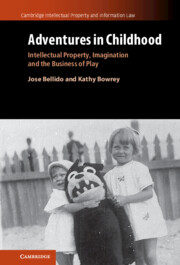Book contents
- Adventures in Childhood
- Cambridge Intellectual Property and Information Law
- Adventures in Childhood
- Copyright page
- Contents
- Figures
- Acknowledgements
- Abbreviations
- Introduction
- 1 Commercialisation and the Innocent Child
- 2 Books, Toy Books and the Artfulness of Consumption
- 3 Instructions for a Successful Boy
- 4 Animated Properties
- 5 Licensing Gone Wrong
- 6 The Rise of Merchandising Agencies
- 7 Troubles at the British Broadcasting Corporation
- Conclusion: Unsuitable for Children
- Index
- Cambridge Intellectual Property and Information Law
2 - Books, Toy Books and the Artfulness of Consumption
Published online by Cambridge University Press: 30 June 2022
- Adventures in Childhood
- Cambridge Intellectual Property and Information Law
- Adventures in Childhood
- Copyright page
- Contents
- Figures
- Acknowledgements
- Abbreviations
- Introduction
- 1 Commercialisation and the Innocent Child
- 2 Books, Toy Books and the Artfulness of Consumption
- 3 Instructions for a Successful Boy
- 4 Animated Properties
- 5 Licensing Gone Wrong
- 6 The Rise of Merchandising Agencies
- 7 Troubles at the British Broadcasting Corporation
- Conclusion: Unsuitable for Children
- Index
- Cambridge Intellectual Property and Information Law
Summary
Tracing the character merchandising of Beatrix Potter, Chapter 2 explores why Potter is both a creative and an industrial author. She directly engaged with the idea of childhood where the parent was a consumer, an idea that affected the direction of her creativity. Potter’s forethought in registering copyright and design rights is much commented on by her biographers. However, at that time, intellectual property law struggled with the very idea of an ‘industrial author’. Although Potter popularised an expanded idea of authorship and intellectual property, she never used her rights defensively to protect the ‘Peter Rabbit’ range of merchandise from imitation and piracy. Rather, incensed by the piracy of The Tale of Peter Rabbit in the United States and frustrated by her dealings with British doll-makers, she was drawn into debates about British manufacturing, the politics of international trade and the reform of tariff law. Potter’s legacy was to encourage the practice of authorising iterations of popular character designs across an ever-increasing range of goods circulating as appropriate gifts for children and decorative embellishment for the home.
Keywords
- Type
- Chapter
- Information
- Adventures in ChildhoodIntellectual Property, Imagination and the Business of Play, pp. 38 - 69Publisher: Cambridge University PressPrint publication year: 2022

